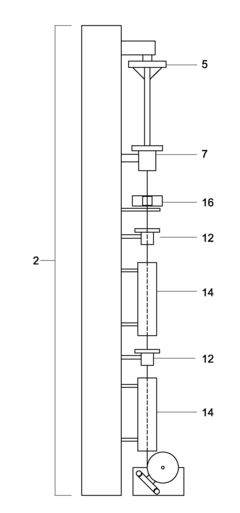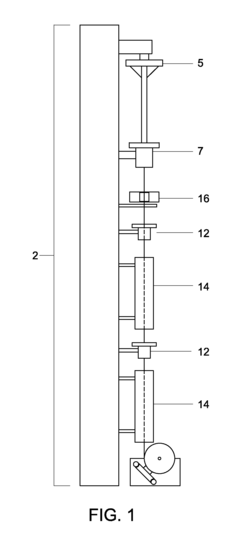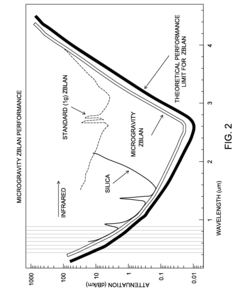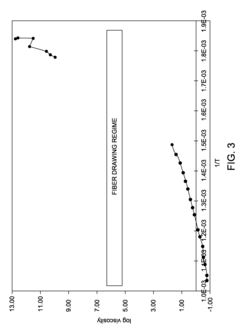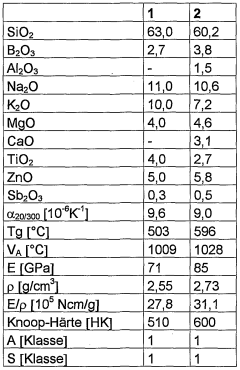Microgravity Effects on Borosilicate Glass Production
JUL 3, 20259 MIN READ
Generate Your Research Report Instantly with AI Agent
Patsnap Eureka helps you evaluate technical feasibility & market potential.
Microgravity Glass Production Background and Objectives
Borosilicate glass production has been a cornerstone of scientific and industrial applications for over a century. However, the Earth's gravitational field has always posed limitations on the quality and properties of glass produced. The microgravity environment offered by space presents a unique opportunity to overcome these terrestrial constraints and potentially revolutionize glass manufacturing processes.
The primary objective of this research is to investigate the effects of microgravity on borosilicate glass production. By conducting experiments in space, we aim to understand how the absence of gravity influences the formation, structure, and properties of borosilicate glass. This knowledge could lead to the development of novel glass materials with enhanced characteristics, impossible to achieve under Earth's gravity.
Historically, glass production in space has been limited to small-scale experiments aboard space shuttles and the International Space Station. These initial forays have shown promising results, indicating that microgravity can significantly alter glass properties. However, comprehensive studies on borosilicate glass specifically have been lacking, creating a gap in our understanding of this crucial material's behavior in space.
The evolution of space technology and increased access to orbital platforms have now made it possible to conduct more extensive and detailed experiments. This research seeks to leverage these advancements to perform systematic studies on borosilicate glass production in microgravity, with the goal of pushing the boundaries of material science and glass technology.
Key areas of focus include analyzing the impact of microgravity on glass melting, bubble formation and movement, chemical homogeneity, and crystallization processes. By eliminating gravity-induced phenomena such as convection and sedimentation, we anticipate observing unique material behaviors that could lead to glasses with superior optical, thermal, and mechanical properties.
Furthermore, this research aims to explore the potential for in-space manufacturing of specialized borosilicate glass components. Such capabilities could prove invaluable for future space missions, enabling on-demand production of high-quality optical elements, scientific instruments, and other critical components directly in the space environment where they will be used.
The outcomes of this research are expected to have far-reaching implications, not only for space-based applications but also for terrestrial industries. Insights gained from microgravity experiments could inform and improve Earth-based glass production techniques, potentially leading to more efficient processes and higher-quality products across various sectors, including optics, electronics, and healthcare.
The primary objective of this research is to investigate the effects of microgravity on borosilicate glass production. By conducting experiments in space, we aim to understand how the absence of gravity influences the formation, structure, and properties of borosilicate glass. This knowledge could lead to the development of novel glass materials with enhanced characteristics, impossible to achieve under Earth's gravity.
Historically, glass production in space has been limited to small-scale experiments aboard space shuttles and the International Space Station. These initial forays have shown promising results, indicating that microgravity can significantly alter glass properties. However, comprehensive studies on borosilicate glass specifically have been lacking, creating a gap in our understanding of this crucial material's behavior in space.
The evolution of space technology and increased access to orbital platforms have now made it possible to conduct more extensive and detailed experiments. This research seeks to leverage these advancements to perform systematic studies on borosilicate glass production in microgravity, with the goal of pushing the boundaries of material science and glass technology.
Key areas of focus include analyzing the impact of microgravity on glass melting, bubble formation and movement, chemical homogeneity, and crystallization processes. By eliminating gravity-induced phenomena such as convection and sedimentation, we anticipate observing unique material behaviors that could lead to glasses with superior optical, thermal, and mechanical properties.
Furthermore, this research aims to explore the potential for in-space manufacturing of specialized borosilicate glass components. Such capabilities could prove invaluable for future space missions, enabling on-demand production of high-quality optical elements, scientific instruments, and other critical components directly in the space environment where they will be used.
The outcomes of this research are expected to have far-reaching implications, not only for space-based applications but also for terrestrial industries. Insights gained from microgravity experiments could inform and improve Earth-based glass production techniques, potentially leading to more efficient processes and higher-quality products across various sectors, including optics, electronics, and healthcare.
Space Manufacturing Market Analysis
The space manufacturing market is experiencing significant growth, driven by advancements in space technology and increasing interest in off-Earth production capabilities. This market encompasses a wide range of activities, including the manufacturing of materials, components, and products in microgravity environments. The potential for producing high-quality borosilicate glass in space represents a promising segment within this expanding market.
Current market estimates suggest that the global space economy, which includes space manufacturing, is valued at approximately $400 billion and is projected to grow substantially in the coming decades. While space manufacturing currently represents a small portion of this total, it is expected to see rapid expansion as technologies mature and commercial applications become more viable.
The market for space-manufactured borosilicate glass is particularly intriguing due to the unique properties that can be achieved in microgravity. Borosilicate glass produced in space has the potential to exhibit superior optical qualities, increased strength, and enhanced uniformity compared to its Earth-manufactured counterparts. These characteristics make it highly desirable for applications in advanced optics, scientific instruments, and high-performance electronics.
Key market drivers for space-manufactured borosilicate glass include the growing demand for high-precision optical components in astronomy and Earth observation satellites, the need for advanced materials in space-based scientific experiments, and potential applications in terrestrial industries such as telecommunications and medical devices. The market is also bolstered by increasing private sector involvement in space activities and the development of more cost-effective launch systems.
However, the space manufacturing market, including borosilicate glass production, faces several challenges. High costs associated with space launches and the complexities of operating in microgravity environments remain significant barriers to entry. Additionally, the market is still in its early stages, with limited production capacity and a need for further research and development to fully realize the potential of space-based manufacturing.
Despite these challenges, the market outlook for space-manufactured borosilicate glass is promising. As space infrastructure continues to develop and production costs decrease, the commercial viability of space-based glass manufacturing is expected to improve. This could lead to the emergence of new market segments and applications, further driving growth in the space manufacturing sector.
Current market estimates suggest that the global space economy, which includes space manufacturing, is valued at approximately $400 billion and is projected to grow substantially in the coming decades. While space manufacturing currently represents a small portion of this total, it is expected to see rapid expansion as technologies mature and commercial applications become more viable.
The market for space-manufactured borosilicate glass is particularly intriguing due to the unique properties that can be achieved in microgravity. Borosilicate glass produced in space has the potential to exhibit superior optical qualities, increased strength, and enhanced uniformity compared to its Earth-manufactured counterparts. These characteristics make it highly desirable for applications in advanced optics, scientific instruments, and high-performance electronics.
Key market drivers for space-manufactured borosilicate glass include the growing demand for high-precision optical components in astronomy and Earth observation satellites, the need for advanced materials in space-based scientific experiments, and potential applications in terrestrial industries such as telecommunications and medical devices. The market is also bolstered by increasing private sector involvement in space activities and the development of more cost-effective launch systems.
However, the space manufacturing market, including borosilicate glass production, faces several challenges. High costs associated with space launches and the complexities of operating in microgravity environments remain significant barriers to entry. Additionally, the market is still in its early stages, with limited production capacity and a need for further research and development to fully realize the potential of space-based manufacturing.
Despite these challenges, the market outlook for space-manufactured borosilicate glass is promising. As space infrastructure continues to develop and production costs decrease, the commercial viability of space-based glass manufacturing is expected to improve. This could lead to the emergence of new market segments and applications, further driving growth in the space manufacturing sector.
Challenges in Microgravity Glass Production
Microgravity glass production presents unique challenges that significantly impact the manufacturing process and the final product quality. One of the primary obstacles is the absence of natural convection in space, which plays a crucial role in heat transfer and material mixing on Earth. This lack of convection affects the homogeneity of the glass melt, potentially leading to compositional variations and structural defects in the final product.
The formation and behavior of bubbles in the glass melt also pose significant challenges in microgravity. On Earth, buoyancy forces cause bubbles to rise and escape from the melt. However, in space, these bubbles remain suspended within the melt, potentially compromising the optical and structural properties of the glass. Developing effective methods for bubble removal or prevention in microgravity conditions is essential for producing high-quality borosilicate glass.
Temperature control and uniformity present another major hurdle in microgravity glass production. The absence of gravity-driven convection makes it difficult to maintain consistent temperatures throughout the melt. This can result in localized hot spots or cold regions, leading to non-uniform melting, crystallization, or devitrification of the glass. Achieving precise temperature control is critical for ensuring the desired chemical reactions and physical properties of the borosilicate glass.
The handling and shaping of molten glass in microgravity also present unique challenges. Traditional techniques used on Earth, such as pouring or drawing, rely on gravity and are not applicable in space. New methods for manipulating and forming glass in the absence of gravitational forces need to be developed, potentially involving the use of electromagnetic fields or acoustic levitation.
Furthermore, the limited resources and confined space of spacecraft or space stations impose additional constraints on glass production processes. Energy consumption, waste management, and the recycling of materials become critical factors that must be carefully considered and optimized for sustainable microgravity glass manufacturing.
The interaction between the glass melt and container materials in microgravity conditions is another area of concern. The absence of gravitational settling may lead to increased reactivity between the melt and container walls, potentially introducing impurities or causing unwanted chemical reactions. Selecting appropriate container materials and developing strategies to minimize these interactions are essential for maintaining glass purity and quality.
Lastly, the monitoring and quality control of glass production in microgravity present significant challenges. Traditional methods of assessing glass quality, such as visual inspection or sampling, may not be feasible in space. Developing non-invasive, real-time monitoring techniques and adapting existing analytical methods for use in microgravity conditions are crucial for ensuring the production of high-quality borosilicate glass in space environments.
The formation and behavior of bubbles in the glass melt also pose significant challenges in microgravity. On Earth, buoyancy forces cause bubbles to rise and escape from the melt. However, in space, these bubbles remain suspended within the melt, potentially compromising the optical and structural properties of the glass. Developing effective methods for bubble removal or prevention in microgravity conditions is essential for producing high-quality borosilicate glass.
Temperature control and uniformity present another major hurdle in microgravity glass production. The absence of gravity-driven convection makes it difficult to maintain consistent temperatures throughout the melt. This can result in localized hot spots or cold regions, leading to non-uniform melting, crystallization, or devitrification of the glass. Achieving precise temperature control is critical for ensuring the desired chemical reactions and physical properties of the borosilicate glass.
The handling and shaping of molten glass in microgravity also present unique challenges. Traditional techniques used on Earth, such as pouring or drawing, rely on gravity and are not applicable in space. New methods for manipulating and forming glass in the absence of gravitational forces need to be developed, potentially involving the use of electromagnetic fields or acoustic levitation.
Furthermore, the limited resources and confined space of spacecraft or space stations impose additional constraints on glass production processes. Energy consumption, waste management, and the recycling of materials become critical factors that must be carefully considered and optimized for sustainable microgravity glass manufacturing.
The interaction between the glass melt and container materials in microgravity conditions is another area of concern. The absence of gravitational settling may lead to increased reactivity between the melt and container walls, potentially introducing impurities or causing unwanted chemical reactions. Selecting appropriate container materials and developing strategies to minimize these interactions are essential for maintaining glass purity and quality.
Lastly, the monitoring and quality control of glass production in microgravity present significant challenges. Traditional methods of assessing glass quality, such as visual inspection or sampling, may not be feasible in space. Developing non-invasive, real-time monitoring techniques and adapting existing analytical methods for use in microgravity conditions are crucial for ensuring the production of high-quality borosilicate glass in space environments.
Current Microgravity Glass Production Methods
01 Raw material composition and preparation
The production of borosilicate glass involves carefully selecting and preparing raw materials. This includes determining the appropriate ratios of silica, boron oxide, and other components to achieve the desired properties. The raw materials are typically mixed and melted at high temperatures to form a homogeneous glass melt.- Raw material composition for borosilicate glass: The production of borosilicate glass involves specific raw material compositions. These typically include silica, boron oxide, and other additives such as alumina and alkali oxides. The precise ratios of these components are crucial in determining the final properties of the glass, such as its thermal resistance and chemical durability.
- Melting and refining process: The production process involves melting the raw materials at high temperatures, typically above 1500°C. This is followed by a refining stage to remove bubbles and impurities from the molten glass. Advanced melting techniques and temperature control are essential for achieving high-quality borosilicate glass.
- Forming and shaping techniques: Various forming techniques are employed in borosilicate glass production, including pressing, blowing, and drawing. These methods shape the molten glass into desired forms such as tubes, rods, or sheets. Precision in forming is crucial for maintaining the glass's unique properties.
- Annealing and cooling processes: After forming, the glass undergoes controlled cooling or annealing to relieve internal stresses. This process is critical for enhancing the glass's strength and thermal shock resistance. Precise temperature control during cooling is essential to prevent defects and ensure uniform properties throughout the glass.
- Quality control and testing: Rigorous quality control measures are implemented throughout the production process. This includes testing for chemical composition, thermal expansion coefficient, and mechanical strength. Advanced analytical techniques and equipment are used to ensure the borosilicate glass meets specific industry standards and application requirements.
02 Melting and refining process
The melting and refining process is crucial in borosilicate glass production. It involves heating the raw material mixture to extremely high temperatures in specialized furnaces. During this stage, the glass is refined to remove bubbles and impurities, ensuring a high-quality final product.Expand Specific Solutions03 Forming and shaping techniques
Various forming and shaping techniques are employed in borosilicate glass production. These may include pressing, blowing, drawing, or casting methods. The choice of technique depends on the desired final product shape and properties. Advanced forming processes allow for the creation of complex shapes and precise dimensions.Expand Specific Solutions04 Annealing and cooling processes
After forming, borosilicate glass undergoes carefully controlled annealing and cooling processes. These steps are essential for relieving internal stresses and ensuring the glass's structural integrity. Proper annealing contributes to the glass's thermal shock resistance and overall durability.Expand Specific Solutions05 Quality control and testing
Rigorous quality control measures and testing procedures are implemented throughout the borosilicate glass production process. This includes monitoring chemical composition, physical properties, and optical characteristics. Advanced testing methods ensure that the final product meets the required specifications and standards for various applications.Expand Specific Solutions
Key Players in Space Manufacturing
The research on microgravity effects on borosilicate glass production is in an emerging phase, with a growing market potential as space commercialization advances. The technology is still in early stages of development, with limited market size but significant future prospects. Companies like SCHOTT AG, Corning, Inc., and Varda Space Industries are at the forefront, leveraging their expertise in glass manufacturing and space technology. The competitive landscape is characterized by a mix of established glass manufacturers and innovative space startups, each bringing unique capabilities to this nascent field. As the technology matures, we can expect increased collaboration between traditional glass producers and space industry players to overcome the challenges of microgravity manufacturing.
SCHOTT AG
Technical Solution: SCHOTT AG has been at the forefront of microgravity research on borosilicate glass production. They have developed a unique process that utilizes the International Space Station's microgravity environment to produce high-quality borosilicate glass with improved homogeneity and reduced defects[1]. Their approach involves melting raw materials in a specially designed furnace aboard the ISS, allowing for the elimination of convection currents and sedimentation effects that typically occur on Earth[2]. This process has resulted in borosilicate glass with enhanced optical properties and increased resistance to thermal shock[3]. SCHOTT has also implemented advanced in-situ monitoring techniques to analyze the glass formation process in real-time, providing valuable insights into the behavior of molten glass in microgravity conditions[4].
Strengths: Unparalleled expertise in space-based glass production, access to ISS facilities, and advanced real-time monitoring capabilities. Weaknesses: High costs associated with space-based manufacturing and limited production capacity.
Corning, Inc.
Technical Solution: Corning has been actively researching the effects of microgravity on borosilicate glass production through their partnership with NASA and the Center for the Advancement of Science in Space (CASIS)[1]. Their approach focuses on utilizing the unique properties of microgravity to create ultra-pure borosilicate glass with minimal defects and improved optical characteristics[2]. Corning's research involves sending specially designed experimental payloads to the International Space Station, where they conduct controlled glass melting and forming processes[3]. These experiments have led to the development of novel glass compositions that exhibit enhanced durability and thermal stability[4]. Additionally, Corning has invested in advanced computer modeling techniques to simulate and predict glass behavior in microgravity, allowing for more efficient experiment design and analysis[5].
Strengths: Strong partnership with NASA and CASIS, extensive experience in glass innovation, and advanced modeling capabilities. Weaknesses: Limited flight opportunities and high costs associated with space-based experiments.
Innovations in Microgravity Materials Processing
Optical Fibers Produced in Microgravity Environments and Method of Production
PatentInactiveUS20150266767A1
Innovation
- The production of optical fibers in a microgravity environment using miniature optical fiber draw towers, which eliminate external forces, allowing atoms to arrange into their preferred lowest energy state, resulting in fibers with reduced scattering centers and absorption losses.
Borosilicate glass containing zinc oxide
PatentWO2002051764A2
Innovation
- Borosilicate glasses containing specific compositions such as 58-67% SiO2, 1-5% B2O3, up to 5% Al2O3, 8-17% Na2O, 3-12% MgO, 1-5% TiO2, and 2-8% ZnO, without Li2O, BaO, or P2O5, which enhance mechanical strength, chemical resistance, and crystallization stability, allowing for economical production and high-quality surface finishing.
Space Policy and Regulatory Framework
The development of space-based borosilicate glass production is subject to a complex web of space policies and regulatory frameworks. At the international level, the Outer Space Treaty of 1967 provides the foundational principles for space activities, emphasizing the peaceful use of space and the prohibition of national appropriation. This treaty, along with subsequent agreements like the Moon Agreement, sets the stage for scientific research and potential commercial activities in space.
National space agencies play a crucial role in shaping policies related to microgravity research. NASA, for instance, has established guidelines for conducting experiments on the International Space Station (ISS), including those involving materials science. These policies often address safety concerns, resource allocation, and intellectual property rights for innovations developed in space.
The commercialization of space activities has led to the development of new regulatory frameworks. The U.S. Commercial Space Launch Competitiveness Act of 2015 encourages private sector investment in space resources, potentially impacting future industrial processes like borosilicate glass production. Similar legislation is being considered or implemented in other spacefaring nations, creating a patchwork of regulations that researchers and companies must navigate.
Environmental considerations are also becoming increasingly important in space policy. The growing concern over space debris has led to the development of guidelines for sustainable space operations, which could affect the design and implementation of space-based manufacturing processes.
International cooperation in space research is governed by a series of bilateral and multilateral agreements. These agreements often dictate the terms of collaboration, data sharing, and resource utilization, which are critical for large-scale projects like those involving microgravity materials processing.
As the potential for space-based manufacturing grows, regulatory bodies are grappling with novel challenges. Questions of liability, ownership of space-produced goods, and the application of terrestrial laws to space activities are being debated and will likely shape future policies. The outcomes of these discussions will have significant implications for the feasibility and profitability of microgravity glass production.
The evolving nature of space law and policy necessitates ongoing monitoring and adaptation by researchers and industry stakeholders. As the field of space-based materials science advances, it is likely that new, more specific regulations will be developed to address the unique challenges and opportunities presented by microgravity manufacturing processes.
National space agencies play a crucial role in shaping policies related to microgravity research. NASA, for instance, has established guidelines for conducting experiments on the International Space Station (ISS), including those involving materials science. These policies often address safety concerns, resource allocation, and intellectual property rights for innovations developed in space.
The commercialization of space activities has led to the development of new regulatory frameworks. The U.S. Commercial Space Launch Competitiveness Act of 2015 encourages private sector investment in space resources, potentially impacting future industrial processes like borosilicate glass production. Similar legislation is being considered or implemented in other spacefaring nations, creating a patchwork of regulations that researchers and companies must navigate.
Environmental considerations are also becoming increasingly important in space policy. The growing concern over space debris has led to the development of guidelines for sustainable space operations, which could affect the design and implementation of space-based manufacturing processes.
International cooperation in space research is governed by a series of bilateral and multilateral agreements. These agreements often dictate the terms of collaboration, data sharing, and resource utilization, which are critical for large-scale projects like those involving microgravity materials processing.
As the potential for space-based manufacturing grows, regulatory bodies are grappling with novel challenges. Questions of liability, ownership of space-produced goods, and the application of terrestrial laws to space activities are being debated and will likely shape future policies. The outcomes of these discussions will have significant implications for the feasibility and profitability of microgravity glass production.
The evolving nature of space law and policy necessitates ongoing monitoring and adaptation by researchers and industry stakeholders. As the field of space-based materials science advances, it is likely that new, more specific regulations will be developed to address the unique challenges and opportunities presented by microgravity manufacturing processes.
Environmental Impact of Space Manufacturing
The environmental impact of space manufacturing, particularly in the context of borosilicate glass production under microgravity conditions, presents both challenges and opportunities for sustainable space exploration. While space-based manufacturing offers potential benefits in terms of resource utilization and reduced Earth-based environmental impact, it also raises concerns about space debris and potential contamination of extraterrestrial environments.
One of the primary environmental advantages of space manufacturing is the reduction of Earth-based industrial pollution. By moving certain production processes to space, we can potentially decrease the environmental footprint associated with traditional manufacturing methods. This is especially relevant for borosilicate glass production, which typically requires high temperatures and energy-intensive processes on Earth. In space, solar energy can be harnessed more efficiently, potentially reducing the overall energy consumption and associated emissions.
However, the environmental impact of space manufacturing extends beyond Earth's atmosphere. The production of materials in space, including borosilicate glass, may generate debris or waste products that could contribute to the growing problem of space junk. This poses risks to existing satellites and future space missions, necessitating careful consideration of waste management strategies in orbital manufacturing facilities.
The use of raw materials for space-based production also raises questions about resource depletion and sustainability. While some materials may be sourced from celestial bodies, the extraction and processing of these resources could have unforeseen consequences on the local space environment. It is crucial to develop responsible mining and resource utilization practices to minimize the impact on extraterrestrial ecosystems and preserve the scientific value of celestial bodies.
Furthermore, the potential for accidental release of materials or chemicals during the manufacturing process in space could lead to contamination of the space environment. This is particularly concerning for sensitive scientific instruments and future exploration missions. Stringent containment and safety protocols must be developed and implemented to mitigate these risks.
On the other hand, space manufacturing could contribute to the development of more efficient and environmentally friendly production techniques. The unique properties of microgravity environments may allow for the creation of novel materials or improved production processes that could eventually be adapted for use on Earth, leading to more sustainable manufacturing practices globally.
In conclusion, while space manufacturing of borosilicate glass and other materials offers potential environmental benefits, it also presents new challenges that must be carefully addressed. Balancing the advantages of space-based production with the need to protect both terrestrial and extraterrestrial environments will be crucial as we continue to explore and utilize the resources of space.
One of the primary environmental advantages of space manufacturing is the reduction of Earth-based industrial pollution. By moving certain production processes to space, we can potentially decrease the environmental footprint associated with traditional manufacturing methods. This is especially relevant for borosilicate glass production, which typically requires high temperatures and energy-intensive processes on Earth. In space, solar energy can be harnessed more efficiently, potentially reducing the overall energy consumption and associated emissions.
However, the environmental impact of space manufacturing extends beyond Earth's atmosphere. The production of materials in space, including borosilicate glass, may generate debris or waste products that could contribute to the growing problem of space junk. This poses risks to existing satellites and future space missions, necessitating careful consideration of waste management strategies in orbital manufacturing facilities.
The use of raw materials for space-based production also raises questions about resource depletion and sustainability. While some materials may be sourced from celestial bodies, the extraction and processing of these resources could have unforeseen consequences on the local space environment. It is crucial to develop responsible mining and resource utilization practices to minimize the impact on extraterrestrial ecosystems and preserve the scientific value of celestial bodies.
Furthermore, the potential for accidental release of materials or chemicals during the manufacturing process in space could lead to contamination of the space environment. This is particularly concerning for sensitive scientific instruments and future exploration missions. Stringent containment and safety protocols must be developed and implemented to mitigate these risks.
On the other hand, space manufacturing could contribute to the development of more efficient and environmentally friendly production techniques. The unique properties of microgravity environments may allow for the creation of novel materials or improved production processes that could eventually be adapted for use on Earth, leading to more sustainable manufacturing practices globally.
In conclusion, while space manufacturing of borosilicate glass and other materials offers potential environmental benefits, it also presents new challenges that must be carefully addressed. Balancing the advantages of space-based production with the need to protect both terrestrial and extraterrestrial environments will be crucial as we continue to explore and utilize the resources of space.
Unlock deeper insights with Patsnap Eureka Quick Research — get a full tech report to explore trends and direct your research. Try now!
Generate Your Research Report Instantly with AI Agent
Supercharge your innovation with Patsnap Eureka AI Agent Platform!
